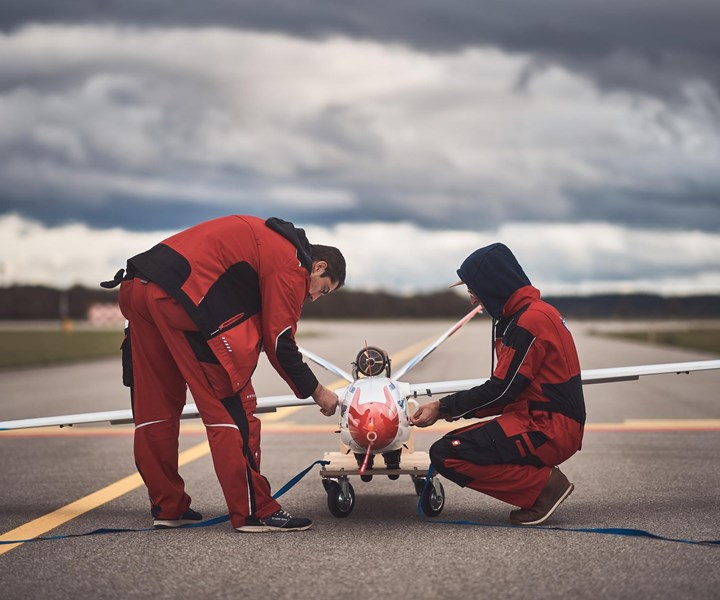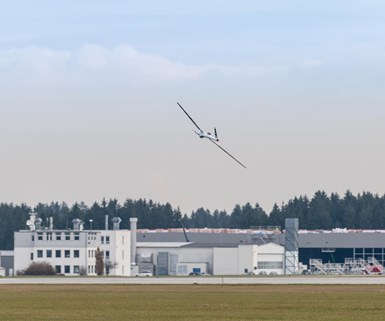CompositesWorld News for Nov. 25, 2019
Read news from Solvay Composite Materials, Penso Group, Arkema, Sartomer Americas, and Hexion
SGL Carbon delivers composite materials for Airbus Helicopter rotor blades
SGL Carbon’s glass fiber noncrimp fabrics enable the composite rotor blades for the 5 blade Airbus H145 rotor configuration.

Source | Airbus
In August 2019, SGL Carbon (Wiesbaden, Germany) began delivering two special glass fiber noncrimp fabrics for the new version of Airbus Helicopters’ (Marignane, France) model H145. The materials are used in the new helicopter’s five-blade rotor. Developed in close collaboration with Airbus Helicopters, the material has been qualified for the application for the foreseeable future.

SGL Carbon’s glass fiber noncrimp fabrics enable the composite rotor blades for the 5 blade H145 rotor configuration. Source | SGL Carbon
Because of their unidirectional fiber orientation, the fabrics offer good resistance and support for the new geometry of the especially long H145 rotor blades. The fabrics are manufactured at the SGL Carbon site in Willich near Düsseldorf in a multi-stage process and delivered to Airbus Helicopters in Paris.
“The order emphasizes our growing presence in the aerospace business. With the fabrics for Airbus Helicopters, we have realized, qualified, and started serial production for a material concept for primary structural components for the first time,” says Dr. Andreas Erber, head of the aerospace segment in the business unit Composites – Fibers & Materials at SGL Carbon.
The current deliveries are part of a framework contract with Airbus Helicopters, intended to gradually intensify collaboration.
The new composite 5 blade rotor configuration for the H145 is said to offer 150 kilograms of additional useful load while also enhancing in-flight comfort, simplicity and connectivity.
Solvay, Penso collaborate on industrialized production of lightweight structures
The FLAVA automotive project has developed composite technologies for creation of a modular, multi-material body-in-white structure for large production volumes.

Source | Solvay
Solvay (Alpharetta, Ga., U.S.) and Penso (Coventry, U.K.) have announced the successful development of composite design, material and manufacturing technologies required to create a modular, multi-material body-in-white structure suited for large production volume.
The consortium was awarded a multi-million pound grant in 2017 by the Advanced Propulsion Centre (APC) for the Flexible Lightweight Architecture for Volume Applications (FLAVA) automotive project. In addition to Solvay and Penso, Mercedes-Benz Vans UK (Milton Keynes) also became a project partner.

Source | Solvay
According to the companies, the project, through the manufacture of composites-intensive vehicle prototypes, demonstrated the technical and commercial solutions required to meet emission legislation with design flexibility, structural integration, lightweighting, vehicle assembly and logistics simplification.
FLAVA contributed to establishing a composite supply chain able to offer manufacturing processes that meet automotive OEM quality, serial production rate and total cost of ownership requirements in standard OEM production facilities.
“Solvay, through FLAVA, was able to further demonstrate composite part manufacture process readiness for large-scale production by investing in R&D (product development and automation), industrializing our composite manufacture and contributing to establish a supply chain for end-customers. FLAVA is a stepping stone for Solvay on our industrialization roadmap,” says Gerald Perrin, automotive global growth director for Solvay Composite Materials Global Business Unit.
Arkema expands high-performance solutions to the 3D printing of composites
Arkema announces partnerships for innovative new solutions for manufacturing continuous fiber composite parts using 3D printing.

A recent partnership combines Continuous Composites’ patented continuous fiber 3D printing technology (CF3D) with Sartomer’s N3xtDimension UV-curable resin solutions. Source | Arkema
Arkema (Colombes Cedex, France) is working to expand the use of its high-performance solutions to the 3D manufacturing of composite materials with the help of new partners.
Continuous Composites (Coeur d’Alene, Idaho, U.S.) and Sartomer (Colombes Cedex, France), an Arkema Business Line, recently announced a partnership combining Continuous Composites’ patented continuous fiber 3D printing technology (CF3D) with Sartomer’s N3xtDimension UV-curable resin solutions. This technology combines the power of composite materials with a snap-curing 3D printing process to create a mold-free and out-of-autoclave composite manufacturing technology. CF3D significantly reduces the cost of manufacturing with lightweight materials offering users greater flexibility and speed of production compared to traditional composite processes. Through this joint development agreement, Sartomer is investing in the R&D and commercialization of resin solutions tailored for CF3D meeting the mechanical properties of varying industries.
In addition, Arkema has partnered with 9T Labs (Zurich), a start-up specializing in the 3D printing of thermoplastic composites that has developed a technology that automates the manufacture of composites using additive manufacturing (AM) and advanced software algorithms. The technology will reportedly enable the mass production of composite parts using Arkema’s Kepstan PEKK. Arkema and 9T Labs will jointly develop the market, focusing on high-volume mass-production applications and material certification in order to accelerate large-scale adoption of the technology.
Through these partnerships, Arkema says it seeks to convert new applications to 3D printing and accelerate the deployment of these technologies in a wide range of industries and applications.
FLEXOP aeroelastic wings achieve first flight
As part of the European Union’s FLEXOP project, DLR and TUM researchers are working on new technologies to control flutter while allowing wings to be made lighter.

Source | DLR
In a collaboration between the German Aerospace Center (Deutsches Zentrum für Luft- und Raumfahrt; DLR, Göttingen, Germany) and the Technical University of Munich (TUM, Munich, Germany), researchers have succeeded in developing new technologies for lighter yet extremely stable wings. The aeroelastic wings made their first flight on November 19 at Oberpfaffenhofen airport (Weßling, Germany).
Wings with longer spans and lower weight generate less drag, and are therefore more energy efficient. The limiting factor for the construction of such wings is the aerodynamic phenomenon of flutter. Wing oscillations increase due to drag and wind gusts.
“Flutter causes material fatigue and can even lead to the failure of the wing attachment to the fuselage," explains Sebastian Köberle, a researcher at the TUM Institute of Aircraft Design.
Although any wing will begin to flutter at sufficiently high speed, shorter and thicker wings have greater structural stiffness, and hence greater stability. Building wings with longer spans that are just as stable and stiff would make them much heavier. In the European Flutter Free FLight Envelope eXpansion for ecOnomical Performance improvement (FLEXOP) project, researchers from six countries are working on new technologies to control flutter while allowing wings to be made lighter.

FLEXOP. Researchers from six countries are working on new technologies to control flutter while allowing wings to be made lighter. Source | DLR
The partners in the EU FLEXOP project are the Hungarian Academy of Sciences (MTA SZTAKI, Budapest, Hungary), Airbus Group Innovation (Ottobrunn, Germany), Airbus Group Ltd. (London, U.K.), FACC Operations GmbH (Ried im Innkreis, Austria), INtegrated Aerospace Sciences COrporation (INASCO, Athens, Greece), Delft University of Technology (Delft, Netherlands), the German Aerospace Center (DLR), the Technical University of Munich, the University of Bristol (Bristol, U.K.) and RWTH Aachen University (Aachen, Germany).
Two wing designs

Aeroelastic wings. DLR’s aeroelastic wings made their first flight on November 19 at Oberpfaffenhofen airport (Weßling, Germany). Source | DLR
TUM researchers are responsible for the design and execution of the flight tests that demonstrate the behavior of the two novel wings developed by the project — the aeroelastic wing and the flutter wing. The TUM team first built the three-and-a-half-meter-long and seven-meter-wide flight demonstrator and integrated the various systems provided by the European partners.
A particularly light wing, which has now been flown for the first time, is an aeroelastically optimized wing constructed from carbon fiber-reinforced composites. It was developed by DLR, in collaboration with Delft University of Technology. The researchers were able to influence its bending and torsional behavior through a special alignment of the fibers during the construction of the wing.
“When the wing is bent by aerodynamic forces, it rotates simultaneously and thereby reduces airflow-induced loads,” says Wolf-Reiner Krüger of the DLR Institute of Aeroelasticity in Göttingen.
With the help of the reference wings, the TUM researchers worked in advance to have the flight demonstrator automatically fly predefined flight test patterns. They devised optimum settings and developed manuals and checklists for the flight tests.
“The flight demonstrator has to fly fast enough with the new wings that they would theoretically have to flutter,” explains Köberle. “We have to be sure that nothing goes wrong at such high speeds.”
Another super-efficient wing developed in the project is the flutter wing. This is a TUM design and is made of fiberglass. If fluttering occurs, the outermost flaps are extended and act like dampers.
“The active flap control developed at DLR considerably increases the possibilities for a much lighter design,” says Gertjan Looye of the DLR Institute of System Dynamics and Control in Oberpfaffenhofen, which manages DLR’s share of the project.
A second flight control system is being developed by the Computer and Automation Research Institute of the Hungarian Academy of Sciences (MTA SZTAKI).
Project Manager Bálint Vanek of MTA SZTAKI says, “Such a wing would make it possible to transport 20% more cargo or to reduce the required fuel by 7%.”
The technology is particularly complex, so tests on this wing will take place at a later date. Both variants of the super-efficient wing have already been evaluated during static vibration tests conducted at the DLR site in Göttingen.
The wings will not only be used on a flight demonstrator. In a further step, the results of the project will be transferred to configurations for transport and passenger aircraft.
Hexion completes Shanghai-based Application Development Center
New Application Development Center will support new product development and customer collaboration to accelerate growth in waterborne coatings and composite applications.

Source | Hexion
Hexion Inc. (Columbus, Ohio, U.S.) has announced the completed construction of its new Application Development Center (ADC) in Shanghai as part of its global efforts to further strengthen its research and development and technical services capabilities. The new 4,800 square meter ADC will support new product development and customer collaboration to accelerate growth in waterborne coatings and composite applications.
“The new ADC is another example of our ongoing commitment to strategically invest in our R&D footprint to increase opportunities for innovation and stimulate growth,” says Craig A. Rogerson, chairman, president and CEO. “With commercial and R&D leaders working in closer proximity, we will leverage their diverse skills in a world-class technology setting ... the investment also demonstrates our ongoing commitment to incorporate sustainability principles into our R&D and product development initiatives.”
According to Rogerson, Hexion expects the new ADC to strengthen the company’s market leading position in China for wind energy applications by developing next-generation solutions based on EPIKOTE and EPIKURE epoxy systems. The ADC will also support further innovation based on Hexion’s EPIKOTE and EPONOL resin systems for automotive applications.
Other environmentally-focused solutions that are expected to further grow with support from the ADC include:
- NextGen Epoxy Waterborne system, offering coating performance comparable to solvent-borne systems while providing for lower volatile organic compounds
- Cardura glycidyl ester, for the production of waterborne and ultra-high solids acrylic polyol resins
- VeoVa vinyl esters, a range of specialty monomers enabling affordable resins for 1K isocyanate-free high-performance protective coatings.
Related Content
Materials & Processes: Fabrication methods
There are numerous methods for fabricating composite components. Selection of a method for a particular part, therefore, will depend on the materials, the part design and end-use or application. Here's a guide to selection.
Read MorePEEK vs. PEKK vs. PAEK and continuous compression molding
Suppliers of thermoplastics and carbon fiber chime in regarding PEEK vs. PEKK, and now PAEK, as well as in-situ consolidation — the supply chain for thermoplastic tape composites continues to evolve.
Read MoreOne-piece, one-shot, 17-meter wing spar for high-rate aircraft manufacture
GKN Aerospace has spent the last five years developing materials strategies and resin transfer molding (RTM) for an aircraft trailing edge wing spar for the Airbus Wing of Tomorrow program.
Read MoreThe state of recycled carbon fiber
As the need for carbon fiber rises, can recycling fill the gap?
Read MoreRead Next
CW’s 2024 Top Shops survey offers new approach to benchmarking
Respondents that complete the survey by April 30, 2024, have the chance to be recognized as an honoree.
Read MoreFrom the CW Archives: The tale of the thermoplastic cryotank
In 2006, guest columnist Bob Hartunian related the story of his efforts two decades prior, while at McDonnell Douglas, to develop a thermoplastic composite crytank for hydrogen storage. He learned a lot of lessons.
Read MoreComposites end markets: Energy (2024)
Composites are used widely in oil/gas, wind and other renewable energy applications. Despite market challenges, growth potential and innovation for composites continue.
Read More















.jpg;maxWidth=300;quality=90)











